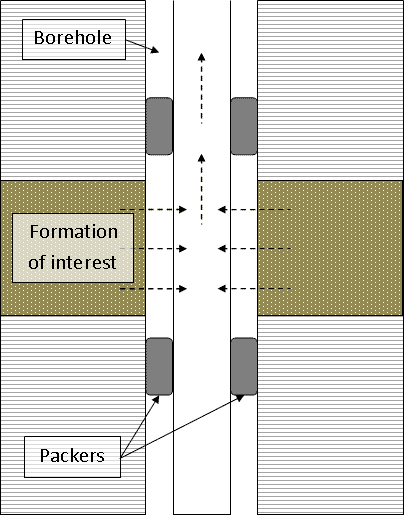Although the popularity of drill stem tests (DST’s) is declining as alternative tools continue to improve, a drill stem test is still sometimes carried out to assess the production potential of a given interval before a well is cased and completed. Unlike wireline pressure sampling tools, which can collect fluid samples at depth and store them until the tool returns to the surface, a drill stem test allows fluids to rise all the way to the surface under natural pressure.
A drill stem testing tool consists of two packers as shown in the below figure, which are used to isolate the formation being tested, and a tube that runs from the isolated zone to the surface. Once the formation in question is isolated, valves are opened in the tool, allowing the hydrocarbons to rise through the tube to the surface, where pressure is measured and samples are collected.
A drill stem test is the most accurate way to study how a formation might produce hydrocarbons once the well is completed. A successful drill stem test is a strong indicator that the well will be a producer. The graphics shown below illustrate the readouts of three different drill-stem tests with different results. The ‘x’ axis is time; the ‘y’ axis is pressure. The pressure response for all three examples first indicates running in the hole with the tool (the pressure increases), then two flow periods, with each flow period followed by a pressure build-up period. The first DST (on the left) looks like a productive well since pressure builds up relatively quickly after the flow periods. The middle one appears to be moderately productive as pressure doesn’t build quite as high. The right test result is not looking good with no pressure building up in the well. These pressure responses are then combined with the fluid samples taken at the surface. For instance, pressure could be shown to be present, but if only water comes to the surface, the well might not be profitable.

Despite the benefits, drill stem testing is somewhat dangerous because deep formations are being opened to surface pressures. If the flow isn’t carefully monitored, it could get out of control and cause a blowout.
Citations
1. Alberty, M. W., 1994, Standard interpretation; part 4 – wireline methods, in D. Morton-Thompson and A. M. Woods, eds., Development Geology Reference Manual: AAPG Methods in Exploration Series 10, 180–185.
2. Bjørlykke, K., & SpringerLink, 2015, Petroleum geoscience: From sedimentary environments to rock physics (2nd 2015. ed.): Berlin, Heidelberg, Springer Berlin Heidelberg, 666 p.
Images: “Drill Stem Test” by Top Energy Training; “Drill_Stem_Test” by Nwhit, via Wikimedia Commons; “Three Drill Stem Tests” by Top Energy Training



